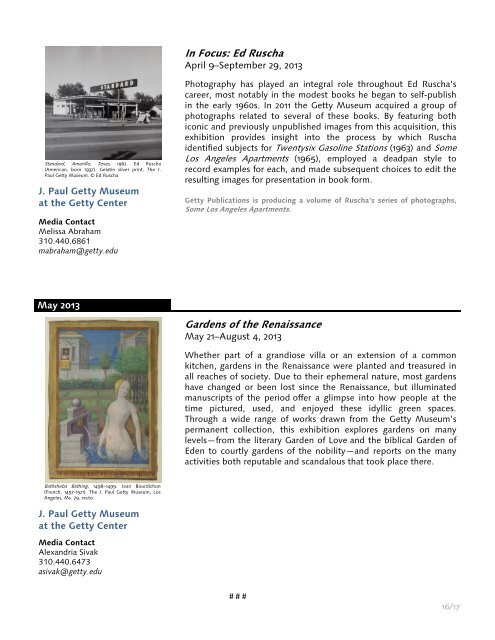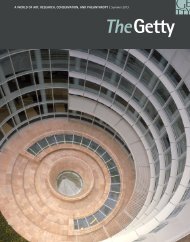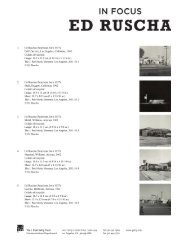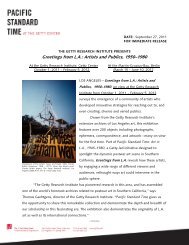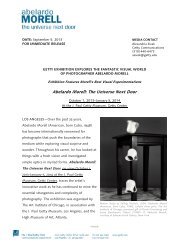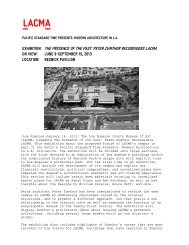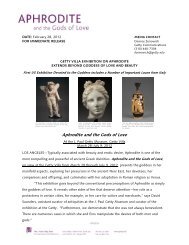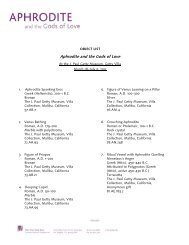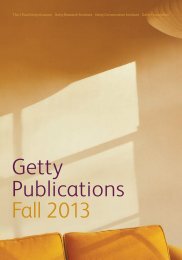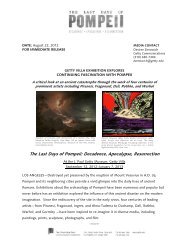Exhibitions at The GETTY - News from the Getty
Exhibitions at The GETTY - News from the Getty
Exhibitions at The GETTY - News from the Getty
You also want an ePaper? Increase the reach of your titles
YUMPU automatically turns print PDFs into web optimized ePapers that Google loves.
In Focus: Ed Ruscha<br />
April 9–September 29, 2013<br />
Standard, Amarillo, Texas, 1962. Ed Ruscha<br />
(American, born 1937). Gel<strong>at</strong>in silver print. <strong>The</strong> J.<br />
Paul <strong>Getty</strong> Museum. © Ed Ruscha<br />
J. Paul <strong>Getty</strong> Museum<br />
<strong>at</strong> <strong>the</strong> <strong>Getty</strong> Center<br />
Media Contact<br />
Melissa Abraham<br />
310.440.6861<br />
mabraham@getty.edu<br />
Photography has played an integral role throughout Ed Ruscha’s<br />
career, most notably in <strong>the</strong> modest books he began to self-publish<br />
in <strong>the</strong> early 1960s. In 2011 <strong>the</strong> <strong>Getty</strong> Museum acquired a group of<br />
photographs rel<strong>at</strong>ed to several of <strong>the</strong>se books. By fe<strong>at</strong>uring both<br />
iconic and previously unpublished images <strong>from</strong> this acquisition, this<br />
exhibition provides insight into <strong>the</strong> process by which Ruscha<br />
identified subjects for Twentysix Gasoline St<strong>at</strong>ions (1963) and Some<br />
Los Angeles Apartments (1965), employed a deadpan style to<br />
record examples for each, and made subsequent choices to edit <strong>the</strong><br />
resulting images for present<strong>at</strong>ion in book form.<br />
<strong>Getty</strong> Public<strong>at</strong>ions is producing a volume of Ruscha's series of photographs,<br />
Some Los Angeles Apartments.<br />
May 2013<br />
Gardens of <strong>the</strong> Renaissance<br />
May 21–August 4, 2013<br />
Whe<strong>the</strong>r part of a grandiose villa or an extension of a common<br />
kitchen, gardens in <strong>the</strong> Renaissance were planted and treasured in<br />
all reaches of society. Due to <strong>the</strong>ir ephemeral n<strong>at</strong>ure, most gardens<br />
have changed or been lost since <strong>the</strong> Renaissance, but illumin<strong>at</strong>ed<br />
manuscripts of <strong>the</strong> period offer a glimpse into how people <strong>at</strong> <strong>the</strong><br />
time pictured, used, and enjoyed <strong>the</strong>se idyllic green spaces.<br />
Through a wide range of works drawn <strong>from</strong> <strong>the</strong> <strong>Getty</strong> Museum’s<br />
permanent collection, this exhibition explores gardens on many<br />
levels—<strong>from</strong> <strong>the</strong> literary Garden of Love and <strong>the</strong> biblical Garden of<br />
Eden to courtly gardens of <strong>the</strong> nobility—and reports on <strong>the</strong> many<br />
activities both reputable and scandalous th<strong>at</strong> took place <strong>the</strong>re.<br />
B<strong>at</strong>hsheba B<strong>at</strong>hing, 1498–1499. Jean Bourdichon<br />
(French, 1457-1521). <strong>The</strong> J. Paul <strong>Getty</strong> Museum, Los<br />
Angeles, Ms. 79, recto.<br />
J. Paul <strong>Getty</strong> Museum<br />
<strong>at</strong> <strong>the</strong> <strong>Getty</strong> Center<br />
Media Contact<br />
Alexandria Sivak<br />
310.440.6473<br />
asivak@getty.edu<br />
# # #<br />
16/17


